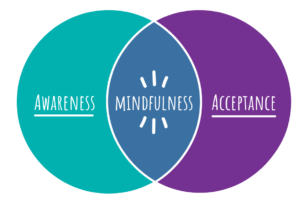What Is Mindfulness?
Mindfulness is the ability to fully engaged in the present moment.
At that moment, you are aware of your thoughts and feelings. In that same moment, you have the ability to uncover and accept different or reoccurring streams of thoughts and feelings without distraction or senses of judgement.¹

Being mindful also has the power to reduce feelings of anxiety, depression, and stress by allowing yourself to be aware and accept how you think and feel. By accepting, and not rejecting how you feel in the moment, you can give yourself the necessary time for self-compassion.
Allowing your body and mind to pause, even just for a couple of minutes, allows your body to recharge, and your mind to eliminate any sort of racing or negative thoughts. The act of mindfulness is to be used in a positive manner.
Practicing Mindfulness
Extensive research confirms that practicing mindfulness can positively boost your mental well-being, improve your attention span and how you bounce back from challenges, otherwise known as your resiliency.
You can decide how, where, and how often to practice your mindfulness. For some, their process is to sit down in a quiet place and begin to take deep breaths, focusing on each one as it enters and leaves the body. To further dive into the moment, focus on engaging in all your senses—smell, sight, hearing, taste, and touch—and ask questions about what you’re experiencing (e.g. What do I smell? What do I hear?)
Below are a few more exercises and resources to help build awareness and accept the state of mindfulness.
Body Scan
The body scan is an easy practice that allows you to get in tune with your body with no thoughts of negativity or judgement—just feeling the release of tension from your muscles.
Follow the steps from 1 – 6, and repeat several times.
- Lie flat on your back and close your eyes;
- Tighten your hands into fists;
- Squish your toes and feet;
- Squeeze your arms and legs;
- After a few seconds, release all your muscles and relax;
- Reflect on how your body feels after doing your body scan.
Another way to observe your body is through a Guided Body Scan Meditation. Allow the softness of someone else’s voice guide you to relaxation.
Three Good Things

Another side to mindfulness is about reflecting on the current people, things, or events that spark joy and happiness despite feeling down sometimes.²
Remember that you are grateful even when you’re sad, frustrated, disappointed, or hurt by challenges that are happening in your life.
Three Good Things is simply just naming three good things at times when you’re not feeling the best. You can do this as a self-reflection activity in your head, or by writing it down and reflecting with it in a silent room.
Doing this often can fill your mind with positive thoughts and gratitude, and develop a habit of thankfulness.
Still Quiet Place
The Still Quiet Place is a comforting place to be when you’re feeling frustrated, sad, angry, scared, or lonely. Just by closing your eyes, and opening up your mind, you can create a safe and peaceful place.³
Developed by Dr. Amy Saltzman, the Still Quiet Place allows negative feelings to melt away and, for calmness and curiosity to take over while in your quiet place.
To find your Still Quiet Place, watch the following Mindfulness Exercise that focuses on creating and designing the Still Quiet Place that you want to be when times get tough.
Other Resources
For more information about the idea and act of mindfulness, and how you can apply it to your life, please watch the following videos;
- All It Takes Is 10 Mindful Minutes – Andy Puddicombe (TED Talk)
- Everyday Mindfulness – AboutKidsHealth (YouTube)
- Mindfulness: Youth Voices – KeltyMentalHealth (YouTube)
Mindfulness takes practice, and also encouragement, whether that is from your support system or yourself. Slowing down your mind for just a couple of moments throughout the day can make all the difference in your school and personal life. Your mental health, as well as your well-being, will thank you.
¹”Mindfulness.” Psychology Today. Accessed May 18, 2021. https://www.psychologytoday.com/ca/basics/mindfulness
²Ackerman, Courtney E. MA. “25 Fun Mindfulness Activities for Children and Teens.” Last modified September 1, 2020. https://positivepsychology.com/mindfulness-for-children-kids-activities/
³Saltzman, Amy. “What Is Still Quiet Place?” Accessed May 18, 2021. http://www.stillquietplace.com/still-quiet-place/

You are not alone. There is help.
If you cannot find someone you trust who is willing to support you, dial a crisis line right away at 403-266-HELP (4357) All crisis lines are confidential.

YouthSMART would like to thank Sagium and Kinsted Wealth for being our 2020 – 2021 website sponsor.
